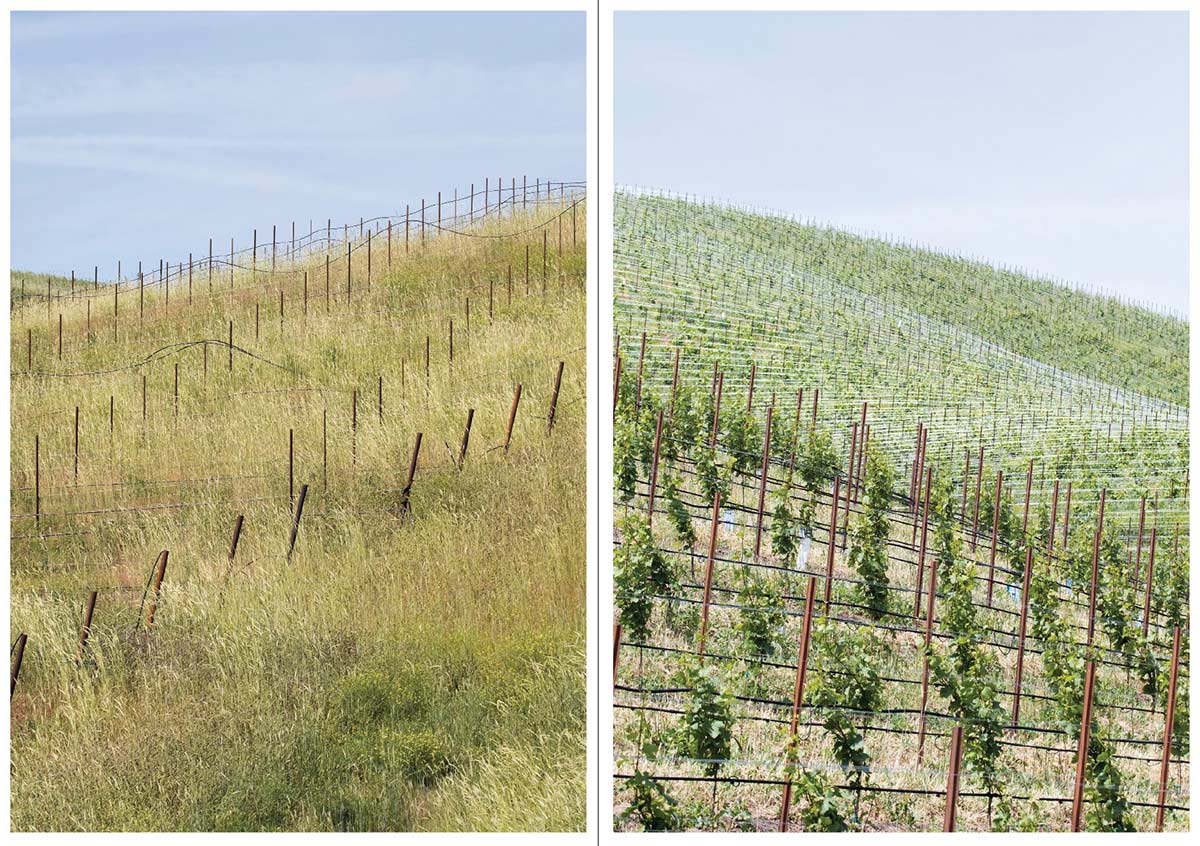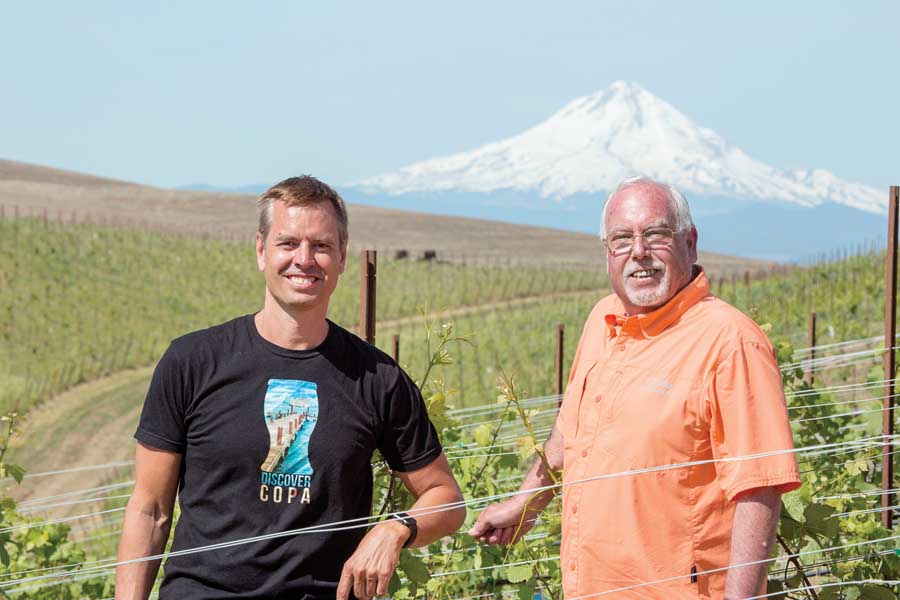
Sunshine Estate Vineyards in The Dalles, Oregon, has 100 acres of Pinot Noir planted on
a former wheat farm, with plans to plant 300 more acres in the coming years. (TJ Mullinax/Good Fruit Grower)
The dry, rolling wheat fields in north-central Oregon have a new neighbor: a vineyard of Pinot Noir grapes that will be planted to 400 acres in the coming years.
The crop isn’t a departure for the people who’ve launched this venture. James Martin and his wife, Molli, represented the fifth generation when they took over her family’s cherry orchards outside Hood River, Oregon.
Over time, they gradually sold the orchards, the last one in 2006, to pursue dreams of entering the wine business.
They started the Quenett wine label in 2003 and patented wine-by-the-glass technology sold under the brand name Copa di Vino.
Today, they are among the largest wine producers in Oregon, bottling just shy of 126,000 cases annually out of their Sunshine Mill Winery in The Dalles, Oregon.
Now, they’re converting wheat fields south of town into Pinot Noir. The Sunshine Estate Vineyards sit in an area with high summer temperatures — their particular spot is averaging about 3,200 degree days a year — and irrigation water comes from deep wells.
The wind blows hard, but the Walla Walla loam shows potential for wine grapes. Already, 100 acres have been planted on their own roots, not grafted as is often the case with this variety, with plans to plant the other 300 acres within the next few years.
“We bought this land from a longtime wheat farmer who had a vision of wanting to do a vineyard, and we took that vision on for him,” Martin said, adding that the combination of higher degree days and heat, along with aspects of the soil and expressions of the self-rooted clones, could prove interesting. “We expect different elements than you get typically with Oregon Pinot Noir, but we think when it’s combined together it’s going to be special and unique.”

James Martin, owner of Sunshine Mill Winery in The Dalles, Oregon, tours the company’s estate vineyard on May 31, 2016 with Dan Rooney. So far 320 acres of Pinot Noir has been planted on what was 480 acres of wheat. (TJ Mullinax/Good Fruit Grower)
Mapping the soil
To gain a better understanding of the soil, Martin and viticulturist Mark Roser turned to a soil mapping system, called the Soil Information System, to create a 3-D profile of the physical and chemical characteristics of the soil, including texture, moisture-holding capacity, macro- and micro-nutrient levels and root zone depth, among other things.
Even though the soil itself seems consistent, any changes to the topography can change the soil characteristics, said Dan Rooney of Trimble Agriculture, the owner of the system.
“We do a lot of mapping of crops where it’s flat, and I can tell you, there’s no such thing as a flat field,” Rooney told growers at an Oregon State University Extension field day at the vineyard in June. Even a tilt a half-percent or 1 percent in one direction makes “a huge difference over time in terms of organic matter and nutrient buildup, and it changes the soils as a function of that topography.”
The models serve as a sort of MRI of the soil, Roser said, and with it they were able to determine vineyard spacing — 7 feet between rows, 5 feet between vines — irrigation blocks and clone selections.
“Even with soil so uniform, we did find some variations, but we added some different clones based on slope and aspect, thinking we could get some different expressions of the fruit,” he said.

James Martin, owner of Sunshine Mill Winery and vineyardist Mark Roser, at their estate vineyard in The Dalles, Oregon on May 31, 2016. The vineyard currently has 320 acres of Pinot Noir planted on a former wheat farm overlooking Mount Hood. (TJ Mullinax/Good Fruit Grower)
So far, five different clones have been planted — clones 113, 459 and 828, Wädenswil UCD 2A and Pommard — on a vertical shoot positioning system. “If you get the right growth spacing, based on your sunlight models, you’re getting good shading for the fruit and getting it good protection,” Roser said of the trellis choice.
“It will take a few years, and a little bit of winemaking to figure this out, to see which ones are giving us what we want,” he said.
Testing new methods
Before planting, Martin and Roser elected to rip the soil underground with a wing-tine ripper to establish the root zone, set at a depth of 28 inches. That meant they fought weeds heavily the first year, so a cover crop of sweet peas and Yamhill wheat has been planted between rows for weed control.
The vineyard also makes use of a hydrocooling system, an idea employed in some areas of California. One line affixed to the trellis supplies irrigation water from two wells on the property, as well as fertigation, while another line supplies water for misting under the same pressure.

A misting system installed at Sunshine Estate Vineyards in The Dalles, Oregon. (TJ Mullinax/Good Fruit Grower)
Roser, who has worked previously with wineries in California, said he had tried misters there on a couple of projects to help cool fruit on the hottest days. The same tactic can be employed in Oregon, he said, noting that the misters played a huge role last year with the high temperatures.
“I find I can drop the temperature of the vineyard down to the low 50s, and just mirror that coastal influence they get down in California,” he said.
Martin agreed. “Last year, it was crazy heat. The crop came on early. We showed no signs of sunburn. We saw really robust berries. No dehydrations,” he said. “Usually young plants are not going to be able to produce fruit of that kind of quality.”
Last year, they harvested their first crop, 7 tons. They plan to plant the remaining 300 acres over the next 10 years — roughly 75 percent of it is already staked — which will increase production by another 135,000 cases, Martin said.
It’s slow going, after the “last painful two years of trying to get large enough production to cover your overhead,” he said. “But from our first harvest, the wines are all tasting like $50 to $70 Pinot. It’s more extracted, has a darker, richer color. Overall, we think we will have a great addition to the Oregon story of Pinot Noir.” •
– by Shannon Dininny with photos by TJ Mullinax






Leave A Comment